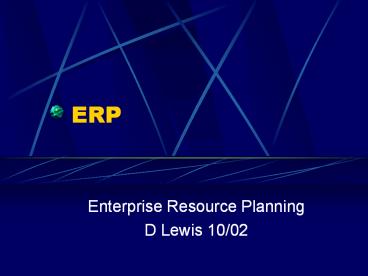ERP - PowerPoint PPT Presentation
Title:
ERP
Description:
May not have best practices included. Why purchase ERP package? ... Readings. evaluation of ERP software. Getting Increased Value from ERP Systems ... – PowerPoint PPT presentation
Number of Views:71
Avg rating:3.0/5.0
Title: ERP
1
ERP
- Enterprise Resource Planning
- D Lewis 10/02
2
Definitions
- ERP is a process of managing all resources and
their use in the entire enterprise in a
coordinated manner - ERP is a set of integrated business applications,
or modules which carry out common business
functions such as general ledger, accounting, or
order management
3
What is ERP?
- Enterprise Resource Planning
- Support business through optimizing, maintaining,
and tracking business functions - Broken down into business processes
- HRM - Distribution
- Financials - Manufacturing
4
What makes ERP different
- Integrated modules
- Common definitions
- Common database
- Update one module, automatically updates others
5
What makes ERP different (cont)
- ERP systems reflect a specific way of doing
business - Must look at your value chains, rather than
functions
6
History of ERP
- Departmentalized Systems
- 1960s systems for each department
- MRP Systems
- 1970s integrated manufacturing
- MRPII System
- 1980s more functions included
- ERP 1990s integrated all across
7
Trends in ERP
- Use of the Internet for access
- More customized solutions
- Decision support capabilities
- Data pulled to specific application
- Linkage of multiple organizations together
8
Benefits of ERP
- Common set of data
- Help in integrating applications for decision
making and planning - Allow departments to talk to each other
- Easy to integrate by using processed built into
ERP software
9
Benefits of ERP
- A way to force BPR (reengineering)
- Easy way to solve Y2K problem
10
Benefits of ERP
- On 4 dimensions
- Firm structure
- Management processes
- Technology platform
- Business capability
11
Firm structure
- New structures
- More disciplined culture
- Globally everyone uses same processes and
terminology - Freely flowing information
12
Management process
- Unified reporting and decision making
- Better data on performance
- Determine which products are more desirable
13
Technology platform
- Single unified all encompassing platform
- Common data, common definitions and formats
14
Business capability
- Form basis of customer driven organization
- Better meet customers needs
15
Buy or Build
- Pros buy
- Best practices from many organizations included
- Vendor must keep up to date
- Smaller staff required
16
Buy vs. Build (cont.)
- Pros build
- Complete control of features
- More support required
- Not as much product support
- May not have best practices included
17
Why purchase ERP package?
- Increasing flexibility and agility
- Business benefits (competitive agility)
- Client/server IT architecture benefits
- IT purchasing benefits
- Lower costs and higher reliability than building
from scratch
18
Why purchase ERP package?
- Data integration
- Improving access to data across business units
- New ways of doing business
- Moving to a process orientation
- Reduction in costs
- Global capabilities
- Common processes and country specific
capabilities
19
Why purchase ERP package?
- IT architecture cost reduction
- Reduced costs for systems operations and
maintenance - Most important benefit?
- Data integration
20
Difficulty in implementation
- Very difficult
- Extremely costly and time intensive
- Typical over 10,000,000 and over a year to
implement
21
Common Pitfalls
- Do not adequately benchmark current state
- Did not plan for major transformation
- Did not have executive sponsorship
- Did not adequately map out goals and objectives
- Highly customized systems to look like old MRP
systems
22
Leading vendors
- SAP
- Baan
- J.D. Edwards
- Oracle
- Peoplesoft
23
Which way to go?
- One vendor
- Easy integration
- Standardization of processes
- Best of breed approach
- Easy to adapt to own needs
- Decreased reliance on one vendor
24
How to implement
- You will need an outside consultant
- Potential benefits
- Better information for
- Strategic decision making
- Greater efficiency
- Greater profit
- Potential for growth
25
Unintended consequences of ERP
- Organizational changes
- Creating new work relationships
- Share information
- Make new types of decisions
- Reactions to changes
- Resistance
- Confusion
- Errors
26
Unintended consequences
- 50 of implementations fail
- Managers underestimate the need for change
management - Managers focus on potential benefit, rather than
on impact on employees - Emotional fallout after employees given greater
responsibility
27
Implementation Issues
- Company may implement only certain modules of
entire ERP system
28
Readings
- evaluation of ERP software
- Getting Increased Value from ERP Systems































